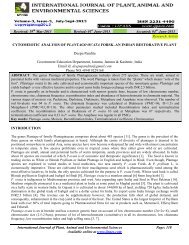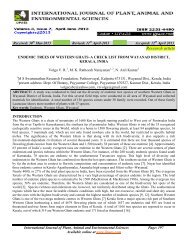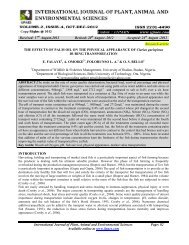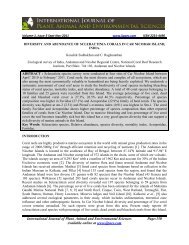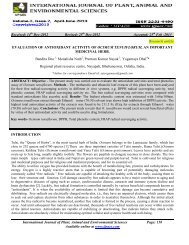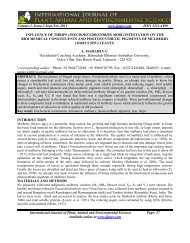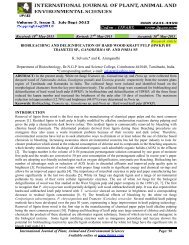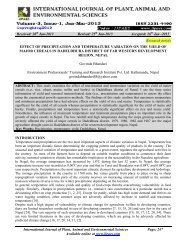siganus canaliculatus - Ijpaes.com
siganus canaliculatus - Ijpaes.com
siganus canaliculatus - Ijpaes.com
Create successful ePaper yourself
Turn your PDF publications into a flip-book with our unique Google optimized e-Paper software.
NOVEMBER 14, 2007 RAIDERS’ Digest Page 3Archbishop Rummel High School: Icons and SymbolsAs the Archbishop Rummel students walkthe halls each day, they pass many icons andsymbols that are rich in history and tradition.At times, this history can go unnoticed orunknown by the everyday Raider. TheRaiders’ Digest feels the need to educate theeveryday Raider and the outsider alike aboutour many icons and symbols that are displayedthroughout the school building.RumpusOne of the lesser-known icons of Rummel is Rumpus.Rumpus, for those that do not know, is the horse on whichRufus proudly resides. In 1978, the Rummel student bodyhad an election to name the then unnamed horse. Afterreviewing hundreds of possibilities, the students voted on“Rumpus” and the name has been the same ever since.“He’s pretty awesome. Every Raider needs a strong horseto ride, you’re not a true Raider without a horse,” saysFreshman Ryan Duvernay.The SealDespite its presence on every Raider uniform, many studentsfail to realize that the school has a school seal. Mr. ThomasMoran, Executive Director of Institutional Advancement,says, “We want everyone to know what Rummel is about- our purpose, our mission, and what we do well.”The crest symbolizes the school in a fourfold manner anddisplays to all Rummel’s mission and purpose. The starsymbolizes the faith of the faculty in the youth and the faithwith which they seek to foster in their students. The huntinghorn symbolizes the man himself, Archbishop JosephFrancis Rummel. The open book symbolizes the knowledgeprovided by Archbishop Rummel High School. And lastly,the state seal of Louisiana represents the devotedness thatshould characterize each Rummel student.RufusIn 1966, Archbishop Rummel asked NewOrleans artist John Chase to draw the thenunnamed Raider on horseback. Also thatyear, Brother John Fairfax, the then principalof Rummel, made a deal with a Raider trackteam member’s mother. He promised Mrs.Puffy Cressend that if her son Rufus, whohad a broken arm, were to win his race, themascot would be named after him. Cressendwon the race and the mascot has been knownas Rufus ever since. Rufus Raider remainsvery popular among the student body. SeniorJonathan Vitale says of Rufus, “He’s coolbecause he shows the Rummel mentality of astrong character.”The “R”The newest addition to the Archbishop Rummel <strong>com</strong>munity iswhat has be<strong>com</strong>e known as “The R”. “The R” has be<strong>com</strong>e the officialsymbol of Archbishop Rummel High School and has already succeededin infiltrating the metro area. Driving around the metro area one caneasily find an “R” on one of the surrounding cars. “The R” has takensome fire lately, as many people <strong>com</strong>plain that it is taking the placeof Rufus. Rufus is and always has been Rummel’s mascot; he is notthe symbol that represents the school. In many ways, Rufus is likeMike the Tiger of LSU. Mike the Tiger is LSU’s mascot; however, theschool’s official symbol is the decorated letters LSU – not Mike theTiger. Despite contrary belief, “The R” is not taking Rufus’s place it ismerely supplementing him and giving the school an official symbol togo along with him.Brother Baker Continues to PromoteService Across Communityby Michael Truxillo ‘09Brother Baker is a very active religionteacher at Archbishop Rummel High.He has done great things in the citysince Katrina and has contributed to therevitalization of the area.To get things organized he announcesto the students to meet on the RummelCampus to travel in a caravan to theplace of interest. Brother Baker hasassisted Mr. Whitman and the YRNO withgutting houses. Brother Baker was alsoin attendance with the Beacon of Hopeorganization when they worked in thedevastated Lakeview area.Brother Baker <strong>com</strong>mented, “On anygiven day we usually have up to twentystudents working and get up to four hoursof work done.”Some of the greatest people BrotherBaker has met are the volunteers that <strong>com</strong>efrom the schools and it gives him a thrillto see good, caring people <strong>com</strong>e togetherunder one purpose.Ever since the Rummel Raider Baseballteam assisted Brother Baker with hisservice projects, more coaches have beeninspired to be<strong>com</strong>e involved with hisservice projects. Many of the serviceprojects simply include cutting the grass,weeding the gardens, and chopping downtrees for the elderly or for those peoplewho have yet to return from Katrina.Brother Baker said, “The thing thatmakes me do this is to help break down thestereotypes for the homeless and the poor.Students begin to genuinely understand thehardships of poverty.”Most of all, Brother Baker feels that theprojects have brought people together andtruly helped those in need. He mentions,“You get more out of it than help, and it’sa <strong>com</strong>mitment, and a sacrifice. It’s morethan just giving a handout, but giving ahand up.”Brother Baker absolutely enjoys thechanges he sees in students’ perspectives.Brother Baker is invigorated when he,“Sees that people are people and have loveand <strong>com</strong>passion.”– • –¤ SERVICE - The Raider baseball team recently volunteered their time withBrother Baker to cut the grass and clean the Lakeview area. Pictured issophomore Jared Gonzales, freshmen Ryan Womac, and sophomore StephenPisa.
Personal, political and professional perspectivesNothing in the foregoing questions or challenges the importance of literacy andnumeracy and raising levels of achievement in these areas. Nothing in the foregoingprecludes a critically important role for state, regional and district levels ofgovernment in providing support for schools, but these must be viewed as enablersrather than regulators. All of these things can be ac<strong>com</strong>plished within a nationalframework that provides the necessary sense of direction.I am not a ‘Johnny <strong>com</strong>e lately’ on these issues. My second book with Jim SpinksLeading the Self-Managing School was published in 1992 (Caldwell & Spinks, 1992).We had the following to say about the impact of high stakes testing in the light ofdevelopments in England where the Conservative Government had introducednational testing in primary and secondary schools and league tables were starting toappear.There are limitations in these approaches to testing, not the least of which istheir narrow focus and the resultant distortion which may occur in learningand teaching, especially for testing at the primary level. Highly valued goalsmay be devalued (Caldwell & Spinks, 1992, p. 142).There will be great pressure to release the raw data of school-by-school<strong>com</strong>parisons in a manner that will distort the accountability process . . . In ourview the strongest possible stand should be taken against the release of suchdata when ac<strong>com</strong>panied by claims or implications of relatively effectiveness(Caldwell & Spinks, 1992, p. 155)I became more sympathetic a decade later when improvements in literacy wereregistered in England as a result of an unrelenting effort by the Blair Governmentwhich expanded the testing and league tables approach of the Conservatives.However, achievement soon plateaued. One of the most powerful advocates,Secretary of State Estelle Morris, resigned when targets for improvement had notbeen achieved.The observations I am making and the conclusions I am drawing should not beinterpreted in a narrow political frame, especially as this symposium is being heldduring a federal election campaign. I am alarmed at what the government is doing inpartnership with the states and territories. I am equally if not more alarmed at whathas been proposed by the opposition which calls for testing at every level from Grade3 to Grade 10 (as reported by Harrison, 2010). Such a proposal shows nounderstanding of the nature and purpose of assessment and testing, nounderstanding of the capacities and potential capacities of the profession and nounderstanding of what has occurred elsewhere and the evidence of harm.Finally, from a professional perspective, it is important to acknowledge that Australiahas the expertise to test well and construct websites like My School. Professor BarryMcGaw and Dr Peter Hill, as Chair and CEO, respectively, of ACARA are at theinternational forefront in respect to their skills in these domains. They lead talentedteams. This is not the issue. The issue is about the purposes that are served and theimpact of the testing and reporting regimes.ConclusionIt is a paradox that Australia is moving to a more constraining, less creative and lessinnovative approach in education at the same time that world leaders in these fields5
Jaikumar IJPAES ISSN 2231-4490REFERENCES[1] Naylor R, Goldburg R, Primavera J, Kautsky N, Beveridge M, Clay J, Folke C,Lubchenco J, Mooney H and Troell M. 2000. Effect of aquaculture on world fishsupplies. Nature 405(6790):1017–1024[2] Sally Washington and Lahsen Ababouch FAO 2011. Private standards and certificationin fisheries and aquaculture . Current practice and emerging issues FAO , Fisheries andAquaculture Technical Paper 553.FAO Rome, 2011.[3] Soliman Victor S, Antonino B. Mendoza, Jr, and Kosaku Yamaoka 2008. SeaweedassociatedFishes of Lagonoy Gulf in Bicol, the Philippines -with Emphasis on Siganids(Teleoptei: Siganidae) Kuroshio Science 2-1: 67-72, 2008[4] Munro I S R 1955. The Marine and Fresh Water Fishes of Ceylon. Halstead Press,Sydney, N.S.W., 351 pp.[5] Day F 1958. The Fishes of India. William Dawson, London, Vol. 1, 778 pp.[6] Herre A W C T,Montalban HR(1928). The Philippine siganids. Philipp. J. Sci., 35: 151-185.[7] Munro I S R 1967. The Fishes of New Guinea. Dep. Agric. Stock Fish., Port Moresby,Papua, 650 pp.[8] Von Westernhagen H 1973. The natural food of the rabbitfish Siganus oramin andSiganus stiolata. Marine Biology, 22(4): 367–370[9] Smith J L B. 1965.The Sea Fishes of Southern Africa. Central News Agency, CapeTown, 580 pp.[10] Pacoli M E. 1983. The farming of siganid in the Philippines. Fish Today. Vol. 5, no. 2,pp. 50-52.[11] Von Wersternhagen H, Rosenthal H. 1976. Some aspects of the suitability of variousPhilippine siganid species for mariculture. Aquaculture (9).[12] Bwathondi P O J . 1982.The potential of marine polyculture in developing countries:Case study in Tanzania. Atlantica, 5(2): 18[13] Cagiltay F. 2003. Culture of the rabbitfish (Siganus luridus Rueppell, 1828). Surunleridergisi/Journal of Fisheries and Aquatic Sciences. Vol. 20, no. 1-2, pp. 257-261.[14] Brown J W, Chirichetti, Crisostomo P D (1994). A cage culture trial of Siganus randallion Guam. Asian Fisheries Science. Metro ManilaVol. 7, no. 1, pp. 53-56.[15] Randall J E. 1995. Coastal fishes of Oman. University of Hawaii Press, Honolulu, HI,439 p.[16] Duray MN. 1990. Biology and culture of siganids. Aquaculture Department, SoutheastAsian Fisheries Development Center, Tigbauan, iloilo, Philippines.[17] Tacon A G J, Rausin N, Kadari M, Cornelius P .1990. The food and feeding of marinefinfish in floating net cages at the National Seafarming Development Centre, Lampung,Indonesia: Rabbitfish, Siganus <strong>canaliculatus</strong> (Park). Aquaculture and FisheriesManagement 21 :375-390.[18] Tawada, S. 1991. Rabbitfishes (Siganus sp.). p. 114-126. In S. Shokita, K. Kakazu, A.Tomori, and T. Toma (eds.), Aquaculture in tropical areas. Midori Shobo Co., Ltd.,Tokyo[19] Tseng.W. Y and K. L. Chan. 1982. The Reproductive Biology Of The Rabbitfish InHong Kong .Journal of world mariculture society.13:1-4. pp 313-321[20] Randall J E, Allen G R, Steene R C 1997. Fishes of the Great Barrier Reef andCoral Sea. University of Hawaii Press, Honolulu, HI, 507 p.[21] Woodland D J 1990. Revision of the fish family Siganidae with descriptions of two newspecies and <strong>com</strong>ments on distribution and biology. Indo-Pacific Fishes. 19, 1-136.[22] Woodland D J 1984. Siganidae. In: FAO species identification sheets for fisherypurposes. Western Indian Ocean (Fishing Area 51), vol. IV. W. Fischer; G. Bianchi(Eds), FAO, RomeInternational Journal of Plant, Animal and Environmental Sciences Page: 62Available online at www.ijpaes.<strong>com</strong>
Jaikumar IJPAES ISSN 2231-4490[23] Saoud IP, Ghanawi J, Lebbos N 2008a. Effects of stocking density on survival, growth,size variation and condition index of the rabbitfish Siganus rivulatus. AquacultureInternational 16, 109–116.[24] Lavina E M, Alcala A C 1973. Ecological studies on Philippine siganid fishes insouthern Negros, Philippines. Abstract (no. MSS/ABS/2/1) submitted to the MarineSciences Special Symposium, Hong Kong, 7–14 December 1973.[25] Ismail W, Wahyuni I S, Pangabean T 1986. Studi pendahuluan pemberian komposisipakan yang berbeda pada ikan beronang Siganus <strong>canaliculatus</strong>. (Preliminary study on the<strong>com</strong>bination of feed for Siganids). J. Penelitian Perikanan Laut, 10(36): 1–5[26] Basyari A, Tanaka H 1988. Study on rearing of siganid fishes by using formula feedwith different crude protein levels. In Seafarming Workshop Report, Bandar Lampung,Indonesia. Technical Report Part 2, 28 Oct. - 1 Nov. 1985, INS/81/008 /GEN/2, June1988, pp. 58–62[27] Meyers SP, et al 1989. Observations on the growth and survival of Rabbitfish (Siganus<strong>canaliculatus</strong>) on three formulated diets. FAO Seafarming Development ProjectINS/81/008, INS/81/008/Technical Paper 5, 1989.[28] Bensan P 1993. Sea Fishes Oceanic Cage Culture Hand Book on Aqua farming, themarine products export development authority, kochi, kerela.pp.1-65.[29] Lam T J 1974. Siganids - their biology and mariculture potential. Aquaculture, 3 : 325-354.[30] Manacop P R 1937. The artificial fertilization of dangit, Amphacanthus oramin (Blochand Schneider). Phaipp. J. Sci.. 62 : 229-237.[31] Hasse JJ, Madraban BB, Mcvey J P .1977. some aspects of the life history of Siganus<strong>canaliculatus</strong> (Park) (Pisces: Siganidae) in Palau. Micronesica,13 (2): 297-312.[32] Mohan R S, Lal (1985). A note on the changing catch trend in the traditional trap-fisheryof Keelakarai and Rameswaram. Indian. Fish, 32 (3): 387-391.[33] Jayasankar P (1990). Some aspects of biology of the white-spotted Spine-foot, <strong>siganus</strong><strong>canaliculatus</strong> (park, 1797) From the gulf of mannar Indian ]. Fish., 37 (1): 9 -14[34] Byran PG, Madraisau BB, McVey JP 1975. Hormone induced and natural spawning ofcaptive Siganus <strong>canaliculatus</strong> (Pisces: Siganidae) year around. Micronesica 11: 199-204.[35] Grandcourt E, Abdessalaam Al, Francis F, Al Shamsi A 2007. Population biology andassessment of the white-spotted spinefoot, Siganus <strong>canaliculatus</strong> (Park 1797) in thesouthern Arabian Gulf. J. Appl. Ichthyol. 23 :53–59[36] Coche AG, Cuzon G, Lichatowich T 1979. Mariculture Develoment in Bahrain. Reporton Feasibility Mission. FAO, Rome. FAO FI-DP/RAB/71/278/6:33-41.[37] Robertson D R. 1990..Differences in the seasonalities of spawning and recruitment ofsome small neotropical reef fishes. J. Exp.Mar. Biol. Fish. 9, 193–223.[38] Sadovy Y.1998. Patterns of reproduction in marine fishes of Hong Kong and adjacentwaters. In: The marine biology of the South China Sea. Proceedings of the ThirdInternational Conference of the Marine Biology of the South China Sea, Hong Kong, 28October - 1 November 1996. B. Morton (Ed.). Hong Kong University Press, Hong Kong,pp. 261–274.[39] Patrick G Bryan , Robert C May, Beketaut Madraisau, James P McVey. 1974 Inducedspawning and larval rearing of the rabbitfish <strong>siganus</strong> <strong>canaliculatus</strong>., south pacific<strong>com</strong>mission, seventh technical meeting on fisheries (Nuku'alofa, Tonga, 15 - 19 July1974)[40] Sadovy Y J 1996. Reproduction of reef fishery species. In: Reef Fisheries. N. V. C.Polunin and C. M. Roberts (Eds), Chapman and Hall, London, pp. 15–59.[41] Bwathondi P O J 1980. The spiny lobster fishery in Tanzania. Paper presented at aSymposium on Coastal and Marine Environments. Khartoum, Sudan (January, 1980).International Journal of Plant, Animal and Environmental Sciences Page: 63Available online at www.ijpaes.<strong>com</strong>
Jaikumar IJPAES ISSN 2231-4490[42] Michael C. Cremer, Hsiang Pin Lan , Jim Zhang. 2004. Evaluation of Rabbitfish as aCulture Species in Ocean Cages at Hainan, China Results of ASA/China 2004 FeedingTrial 35-04-106, American Soybean Association.[43] Sabapathy U, Teo L H 1993. A quantitative study of some digestive enzymes in therabbitfish, Siganus <strong>canaliculatus</strong> and the sea bass, Lates calcarifer. Journal of FishBiology 42, 595–602.[44] Yousif O M, M F Osman, AR Anwahi, M A Zarouni, T Cherian 2005. Growthresponse and carcass <strong>com</strong>position of rabbitfish, Siganus <strong>canaliculatus</strong> (Park) fed dietssupplemented with dehydrated seaweed, Enteromorpha sp. Emir. J.Agric. Sci. 16(2): 18-26[45] M.Jaikumar, L.Kanagu, C.Stella, Gunalan 2011. Culturing A Rabbit Fish (SiganusCanalicullatus) In Cages an Alternative Source For Fisherflok In Mandapam Coast (Palk– Bay South East Coast of India) IJWREE, (International Journal of water resources andEnvironment Engineering) 3(11):251-257International Journal of Plant, Animal and Environmental Sciences Page: 64Available online at www.ijpaes.<strong>com</strong>



